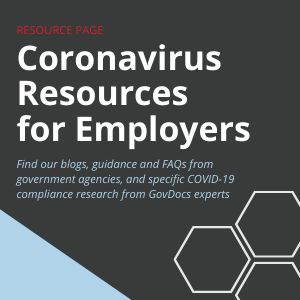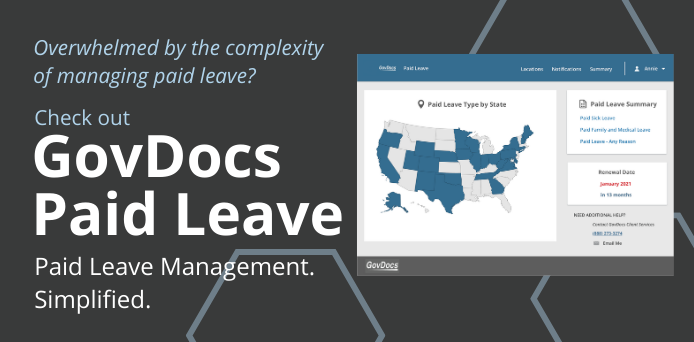EMPLOYMENT LAW NEWS
COVID-19 Paid Leave Laws and How They Interact with Existing Leave Laws
By Kris Janisch
Published Sept. 29, 2020

A recent GovDocs webinar about COVID-19-related paid leave laws outlined specific new and updated laws, and employer responsibilities.
Even as employers are doing more with less during the coronavirus pandemic, lawmakers are adding additional responsibilities regarding paid leave and COVID-19.
Jana Bjorklund, GovDocs’ Senior Counsel, Employment Law, examined the impact of recently enacted COVID-19 paid leave laws on standing laws during our latest webinar.
The hour-long session helped explain employer obligations, the relationship between COVID-19 paid leave laws and existing laws, and guidance on how to apply them.
Below, we will recap some of the highlights, focusing on post-webinar feedback from attendees.
State COVID-19 Family and Medical Leave Laws
Seven states plus Washington, D.C., have passed expanded family and medical leave (FMLA) for COVID-19-related reasons.
Among them, however, there are many differences regarding eligible reasons for use. Bjorklund highlighted some of the specifics.
Washington
Covers employees ill with COVID-19 or caring for family member with COVID-19. It doesn’t cover employees who are unable to work due to quarantine, or to care for child due to school closure or care provider closure. Here, the law does not coincide with the Families First Coronavirus Response Act.
Oregon
Covers care for child due to school closures. The time off unpaid but job protected.
California
Covers care for family member ill or quarantined. School closures do not qualify.
New York
Covers quarantine or isolation due to COVID-19 for employee and child. It also covers employees ill with COVID-19 or caring for family member with COVID-19.
Connecticut
Covers employees sent home because of a fever.
New Jersey
Covers care for family member due to quarantine or illness and need to care for child due to school closure or care provider closure.
Rhode Island
Covers employee ill due to COVID-19 or caring for family member with COVID-19. A seven-day waiting period, under its standing law, may be waived.
Washington, D.C.
Allows 16 weeks of COVID-19-related leave to care for self, family member or due to childcare closure. The leave terminates when public health emergency has ended — even if an employee has not exhausted the 16-week entitlement. This is unpaid but significant to note because it is in addition to D.C. FMLA.
“Arguably, an employee could, potentially, have 32 weeks of leave, job protected, if they need the full 16 weeks for COVID 19 eligible reasons, then go into a situation where they need the standard paid family leave,” Bjorklund said.
COVID-19 Paid Leave Laws
Paid sick leave (PSL) laws related to COVID-19 have been passed at the city, county and state levels.
 Reasons for use include typical reasons:
Reasons for use include typical reasons:
- Quarantine for employee or family member
- Testing
- Business closures
- School closures requiring an employee to care for a child
The states with PSL laws related to COVID-19 include California, Nevada, Arizona, Washington, Colorado, Michigan, New York, Vermont, Connecticut, New Jersey, Rhode Island and Massachusetts, as well as Washington, D.C.
In addition, five counties have PSL coronavirus laws.
“Big, surprise,” Bjorklund joked, “three are in California. Who could have guessed that? I wouldn’t have been surprised if all five were in California.”
Still, employers with locations in California should know that nearly all workers there are covered by COVID-19 related leave laws.
Sonoma, San Mateo and Los Angeles Counties
COVID-19 paid sick leave applies to employers with 500 or more employees.
“They’ve been filling in the gaps around what was left after the federal regulations were passed,” Bjorklund said.
Cook County, Ill.
Covers school closures, childcare provider closures and business closures due to public health emergency.
Montgomery County, Md.
Covers school closures, childcare provider closures and business closures due to public health emergency along with need to care for family member due to quarantine or isolation due to COVID-19.
“Each law is a little different. You have to take the time to review and understand and know what the different variations are in the jurisdictions,” Bjorklund.
Meanwhile, several cities have PSL laws related to the coronavirus. Often, these laws have been amended to include COVID-19-related reasons under existing ordinances. A few of the additional reasons include:
- Los Angeles and San Diego allow paid sick leave use if the employee is 65 or older and has a serious chronic medical condition described by the Centers for Disease Control and Prevention.
- Los Angeles also has supplemental PSL for companies with 500 or more employees — 80 hours for dealing with COVID-19
- Seattle allows use of paid sick leave when a family member’s school or care provider is closed regardless of whether it was directed to close by a public health official.
- Duluth, Minn., allows use of paid sick leave for coronavirus screening, testing or quarantine following contact with infected or symptomatic person.
- Philadelphia allows use of paid sick leave for preventive medical care related to COVID-19, including quarantine or orders from health commissioner that residents of certain areas of state must not travel and travel would be necessary to report to work.
Coordinating Regular Paid Leave and COVID-19 Paid Leave Laws
So, how do all these laws interact?
Bjorklund ran down a general list:
- FFCRA — This applies first, if applicable
- Check for other leaves available — state, county, city, employer policy
- COVID-19 next — some may allow credit to reduce employer sick leave
- Run leaves concurrent when applicable
- Watch reason for leave — laws vary
They’re all a little different, and employers should keep a close eye on covered reasons.
“The takeaway here is that there are no shortcuts on this. These types of issues, when an employee is taking leave for these reasons, the laws are complex and there are many of them. Slog through the information, review everything,” Bjorklund said.
Conclusion
Despite the latest information during the Sept. 23 webinar, Bjorklund cautioned employers to remain vigilant.
“It’s going to change,” she said. “Probably tomorrow. If not today already.”
Employers must understand where these laws exist, whether the business itself falls under the FFCRA, and know reasons for use, benefits and other facets of COVID-19 paid leave laws.
It’s a lot to tackle. Be sure to watch the entire webinar for more details.
Also, check back on Employment Law News for a California-specific post, and answers to questions from employers during and after the webinar.
This Employment Law News blog is intended for market awareness only, it is not to be used for legal advice or counsel.
Keep Informed
with GovDocs Labor Law News

What is GovDocs?
GovDocs simplifies employment law compliance for large, multi-jurisdiction employers in the U.S. and Canada. The GovDocs software platform integrates three solutions in one convenient place to help you master the employment laws impacting your business. Whether you manage a postings, minimum wage or paid leave program, our products cut through research time, provide proactive insights into the everchanging landscape of employment laws and reduce the risk of noncompliance. The company is headquartered in St. Paul, Minn.
Have fewer than 30 locations?
The GovDocs Poster Store simplifies posting compliance for employers with less than 30 locations across all industries, offering a variety of posting products to meet your labor law compliance needs.



